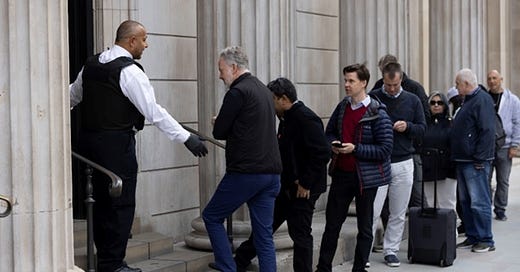Bank of England Update: A discussion with Huw Pill, the chief economist
What are the UK economy’s biggest challenges? Impressions from a discussion beyond the interest rate discourse
Image 1
12 June 2024. London. Queues outside the Bank of England. But what looks like an old-fashioned bank run is merely fans of the King wanting to swap their Bank of England promissory notes with the picture of his mother against the new ones with his image on them. These were released on 5 June 2024. (Swapping old Bank of England notes for the new ones can be done at the Bank of England until 30 June 2024 after filling in a form, provided there is a UK address).
Meanwhile, market participants and commentators alike have, as usual, been mesmerised by the debate on whether the Bank of England may cut interest rates, potentially as early as this month. UK unemployment, announced on 11 June 2024, came in higher, and today’s April GDP monthly figures weaker than expected. Meanwhile, a report by the Resolution Foundation, headed by Tory peer David Willetts as president, helpfully reminded us that UK GDP has been contracting for a number of years on a per capita basis (also true for other European economies that have been expanding their population by importing migrants, such as Germany; of course German GDP has even been contracting on a non-per capita basis).
With the ECB cutting interest rates on 6 June (from 4% to 3.75%), having held them steady for almost five years, and following a cut by the Canadian central bank the day before, journalists state that “the pressure is on the Bank of England” to follow suit.
Already on 14 May 2024, the Bank of England’s chief economist, Huw Pill, raised the spectre of an early rate cut. Neither central bankers nor economists like to express things clearly and simply. Here is how he said it:
“I think it’s not unreasonable to believe that through the Summer we will begin to see enough confidence in the decline in persistence that Bank rate will come into consideration.”
Huw Pill, chief economist, Bank of England, 14 May 2024, ICAEW event
All crystal clear? The ”persistence” refers to inflation. “Bank rate”, without the definite article “the” in front of it, is code for the Bank of England base rate, presently at 5.25%.
This comment follows the statement by Bank of England Governor Andrew Bailey that a rate cut in June could not be “ruled out”. It also revises up Huw Pills prior assessment, earlier in May, that a “heavy focus” on a June rate cut was “ill advised”.
In this context I thought readers might like to hear about my visit to the Bank of England and meeting with Huw Pill, the chief economist, which took place a little more than two months ago, on 28 March 2024. Huw Pill explained his view of the state of the UK economy and the challenges for Bank of England monetary policy.
Keep reading with a 7-day free trial
Subscribe to Richard Werner’s Substack to keep reading this post and get 7 days of free access to the full post archives.





